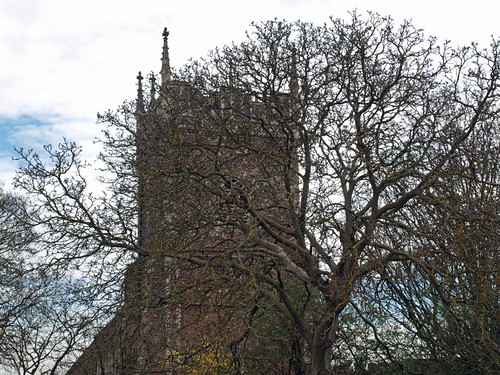ST LEONARD. Close to the street. Impressive but much restored. The battlements and pinnacles of the C14 W tower (angle buttresses) e.g. are new. The S porch is rebuilt, the (embattled) S aisle has new windows. The N side is more rewarding. N aisle of c. 1330, N chancel chapel of c. 1500. The N arcades show these dates clearly too. The piers of the Dec style are quatrefoil, as usual, the C15 piers are of four shafts and four hollows in the diagonals. The arch mouldings differ too. The C15 type appears in the S arcade, the W bay of the N arcade and both chancel chapels. Modest hammerbeam roof in the nave. - FONT. Octagonal, Perp, with shields in quatrefoils and big leaves. - PLATE. Fine Mazer with gilt rim, 1521; large Elizabethan Cup; large Cup probably of 1624; Paten of 1713.
St
Leonard’s is at the Hythe, a 14th century church with a beautiful
hammerbeam roof 400 years old, richly moulded, and well lit from the
clerestory. Four angels which once held it up are in the vestry. The
roofs of two chapels are a century older than the nave’s. There are six
old chairs, a mazer bowl of 1521 with a silver rim, and an Elizabethan
cup with two bands of ornament, and two medieval bells still ringing in
the tower, from which a remarkable clock face of stone looks down. It is
as old as 1500 and has carved spandrels. Two heads which once supported
the roof beam still project from the walls at the chancel arch. The
windows are attractive with 24 big figures, among them Thomas Becket,
Helena, Ethelbert, the Confessor, and Charles Stuart. The door by which
we come and go is 500 years old and pierced with holes made by the
bullets of the Parliament men in the Civil War.
Simon K -
One of the survivors was St Leonard. Set on the Hythe, the old
Colchester port area, now a rundown area of 19th century streets and
warehouses, but 'coming up' with apartments along the waterfront. This
was the former parish church, but is now redundant and in the care of
the CCT.
St Leonard is the biggest and grandest church in Colchester, about a mile from the town centre. It would not be out of place in rural Suffolk, with aisles and a clerestory, and its tower surmounted with flushwork and pinnacles. The church is open Tuesdays and Saturdays, with a keyholder notice at other times, but both keyholders were out, which was my big disappointment of the day.
The south door has repaired musket ball holes in it - the Siege of Colchester was broken here when the Royalists guarding the river crossing were overpowered by a regiment of Suffolk parliamentarians who took the church and laid open the way into the centre of the Borough. An extraordinary prospect, looking up Hythe Hill.
Simon K -
Colchester is unusual, and perhaps unique in England, because for a
town of 150,000+ people it has no large central church. There were
nine small medieval parishes, each with its own small church, but none
as big as Ipswich's St Mary le Tower, or Norwich's St Peter Mancroft,
or Cambridge's St Mary the Great. They suffered two depredations that
churches nowhere else in England had to suffer - most were ruined
during the 1648 Seige of Colchester (being the only fortified
buildings in town, the Royalists holed up in them and they were
attacked by the Parliamentarians) and then the earthquake of 1884,
after which two of them were demolished.
St Leonard is the biggest and grandest church in Colchester, about a mile from the town centre. It would not be out of place in rural Suffolk, with aisles and a clerestory, and its tower surmounted with flushwork and pinnacles. The church is open Tuesdays and Saturdays, with a keyholder notice at other times, but both keyholders were out, which was my big disappointment of the day.
The south door has repaired musket ball holes in it - the Siege of Colchester was broken here when the Royalists guarding the river crossing were overpowered by a regiment of Suffolk parliamentarians who took the church and laid open the way into the centre of the Borough. An extraordinary prospect, looking up Hythe Hill.

No comments:
Post a Comment